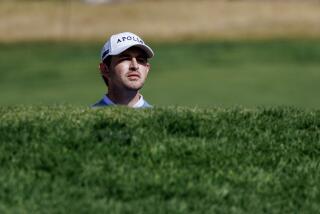Janzen Finds Fifth-Hole Angel Still Around
- Share via
SAN FRANCISCO — An angel lives on the fifth hole of the Olympic Club.
No one has ever seen her, but author Curt Sampson wrote about her in a book on Ben Hogan. He said she visited Jack Fleck on the fifth green during the second round of the U.S. Open here in 1955, the year Fleck stunned the golf world with his victory over Hogan.
Fleck believes it’s true. A notoriously weak putter, he says he felt a mysterious tingling in his hands there that day, giving him a sense of invincibility on the greens.
When he later retired to Arkansas, he and his son transformed a cow pasture into a small golf course and named it “Lil’ Bit A Heaven.”
On Sunday, thirty-three years after Fleck was touched by an angel, Lee Janzen teed off on the Olympic Club’s fifth hole in the final round of the 98th U.S. Open.
Aware of a wind that had blown right to left all week, he overcompensated and hit his four-wood shot too far to the right, into the trees lining the fairway.
Janzen was dismayed. After beginning the day five strokes out of first place, he bogeyed the second and third holes and fell seven strokes behind Payne Stewart. But Janzen was feeling better about his game after reclaiming a stroke with a 20-foot birdie putt on the fourth, until his drive on five went into the woods.
That’s not unusual at the Olympic Club. When the 35,000 trees on the course undergo their regular trimming, hundreds of errant balls fall from them.
Tommy Nakijima hit a ball into a tree here during the U.S. Open in 1987 that, as far as anyone knows, never came down.
Janzen feared his ball might suffer a similar fate when the marshalls couldn’t find it. He stopped in mid-stride, grabbed another ball from his caddy and started back toward the tee box to hit another drive.
“Originally,” Janzen said later, “when I started walking back to the tee, thinking my ball was stuck in the tree, I thought, ‘This just isn’t right. I’ve just made a birdie to turn things around. Now I’m going to be lucky to make a double bogey.”’
But before he reached the tee box, he heard someone yell he had spotted the ball in a tree with his binoculars. Then, the same precarious wind that had put Janzen in this position in the first place, rustled through the branches, loosening their grip on the ball.
The angel could have been kinder. When the ball fell to the ground, it landed in the deep rough. But that was better than the tree.
Janzen chipped into the fairway, hit a six-iron approach that flew over the green, then chipped in.
“You can imagine how much better I felt walking off that hole with a par,” he said.
Three hours later, he was the U.S. Open champion for a second time with a one-stroke victory over Stewart, who, coincidentally, also was the runnerup when Janzen won five years ago.
In the final round in 1993, it was Stewart who rallied to catch Janzen on the back nine, only to have Janzen win the tournament with three birdies on the last five holes, including a chip in on the 16th.
“I guess I bring the best out in Lee Janzen,” Stewart said.
But there will be a debate about whether Janzen won this one or Stewart lost it. A more appropriate topic for discussion might revolve around the reason the angel smiled on one and not the other.
For sure, she was not there for Stewart.
When the 1991 U.S. Open champion entered the final 18 holes with a four-stroke advantage, larger than any third-round leader has had since Tony Jacklin in 1970, the order of the day seemed to call for a coronation, not a competition.
And what a fitting tribute a victory on Father’s Day would have been to Stewart’s late father, Bill, an amateur champion who played in his only U.S. Open on this same course in 1955. Stewart’s mother, Bee, was here, then and now.
It was now that he could have used a little divine intervention. Instead, he got a sand divot in the middle of the 12th fairway.
For those without a golf glossary at hand, that is a divot that tournament officials have chosen to fill with sand. By the end of the fourth day of play here, there were so many sand divots on some holes that Tiger Woods said the fairways looked like minefields.
Stewart’s otherwise superb drive on the 416-yard, par four 12th bounced into one of them, the world’s tiniest sand trap.
He contemplated his shot, changed clubs, and then hit--into a genuine sand trap guarding the green.
Adding insult to misery, a USGA official approached Stewart after the shot and warned him for taking too much time.
“That didn’t sit real well,” Stewart said.
But there you have it, the two shots that determined the U.S. Open champion. One fell out of a tree, the other bounced into a divot. If either had gone the other way, so might have the tournament.
Stewart went on to bogey the hole, losing sole possession of the lead for the first time since early in the first round by falling into a tie with Janzen, who, after his unlikely par on the fifth hole, birdied the seventh, 11th and 13th. He parred out for a two-under par 68.
Despite three more bogeys, Stewart still had a chance to send the tournament into an 18-hole playoff today before his 20-foot birdie putt on 18 curled left inches short of the hole.
Stewart finished with a four-over 74, one-over 281 for the tournament. Janzen finished at even par 280.
It is not a memorable winning score. Janzen will not be able to say that he conquered the Olympic Club. But he can say, as he did Sunday, that it’s his favorite course.
Of course, it is. To him, it’s a lil’ bit a heaven.
More to Read
Go beyond the scoreboard
Get the latest on L.A.'s teams in the daily Sports Report newsletter.
You may occasionally receive promotional content from the Los Angeles Times.










